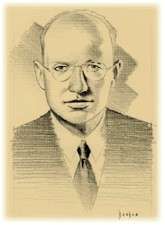Oliver Ellsworth Buckley
| Oliver Ellsworth Buckley | |
|---|---|
 | |
| Born |
August 8, 1887 Sloan, Iowa |
| Died |
December 14, 1959 (aged 72) Newark, New Jersey |
| Residence | United States |
| Nationality | American |
| Fields | Electrical engineering |
| Alma mater | Cornell University |
| Notable awards | IEEE Edison Medal (1954) |
Oliver Ellsworth Buckley (August 8, 1887 – December 14, 1959) was an American electrical engineer known for his contributions to the field of submarine telephony.
Biography
Buckley joined the Bell System after completing his PhD in physics at Cornell University in 1914. In 1915, Oliver Ellsworth Buckley, along with AT&T coworkers H. D. Arnold and Gustav Elmen, developed a method of substantially improving the transmission performance of submarine communications cable so that transmission speed of over 2000 letters per minute were achieved.[1] They constructed the cable by wrapping the copper conductors with annealed permalloy tape, a material that Elmen had discovered, thus inductively loading the cable.
Buckley was the president of Bell Labs from 1940 to 1951, and chairman of the board from 1951 until his retirement in 1952.[2]
Buckley received the IEEE Edison Medal for "contributions to the science and art which have made possible a transatlantic telephone cable; for wise leadership of a great industrial laboratory; for outstanding services to the government of his country". The Oliver E. Buckley Condensed Matter Prize is named in his honor.
References
- ↑ A. A. Hurdeman, The Worldwide History of Telecommunications, Wiley Interscience (2003), p.314
- ↑ Buckley biography by Bell Labs
External links
- IEEE Buckley biography
- Biographical Memoirs from The National Academy of Sciences by Mervin J. Kelly